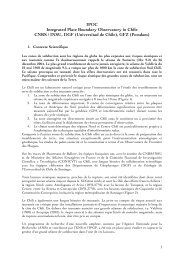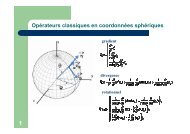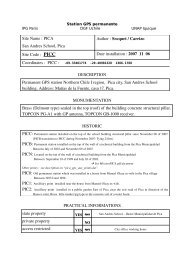PDF file - Laboratoire de Géologie de l'Ecole normale supérieure - Ens
PDF file - Laboratoire de Géologie de l'Ecole normale supérieure - Ens
PDF file - Laboratoire de Géologie de l'Ecole normale supérieure - Ens
Create successful ePaper yourself
Turn your PDF publications into a flip-book with our unique Google optimized e-Paper software.
VIGNY ET AL.: GEODETIC MEASUREMENTS MONITOR ASAL RIFT DEFORMATION<br />
from using the overall mis-closure to estimate, aposteriori,<br />
an overall drift proportional to the distance<br />
covered. Also, the measurements stopped short of the<br />
end point of the 1973 line in the far field.<br />
Consequently, we must rely on the analysis of internal<br />
errors and biases to evaluate the level of precision in<br />
this leveling pro<strong>file</strong>. The lines of sight were kept<br />
short: 15 m on average and very seldom longer than<br />
30 m (Aux. Figure 1a). Forward and backward lines of<br />
sight were symmetric within 10 to 20% to cancel out<br />
any asymmetric behavior of the leveling instrument<br />
(Aux. Figure 1b). We avoi<strong>de</strong>d as much as possible<br />
hitting the surveyor’s pole at low heights, too close to<br />
ground level where atmospheric distortions are largest<br />
(Aux. Figure 1c). Finally, the ten small loops of length<br />
shorter than 1 km all closed with 1 mm, without any<br />
systematic trend (Aux. Figure 1d). Consi<strong>de</strong>ring all<br />
these reasons together, we can exclu<strong>de</strong> systematic<br />
errors as the cause of the uplift observed on the NE<br />
si<strong>de</strong> of the rift.<br />
However, a change of height does not necessarily<br />
imply a change of topographic elevation. It could be<br />
that the local geoid changed over the 15 years time<br />
span between the two leveling pro<strong>file</strong>s. In<strong>de</strong>ed, some<br />
indication that this may have occurred comes from<br />
gravity measurements conducted in the area in 1999<br />
[Ballu et al., 2003]. These measurements suggest that<br />
the gravitational acceleration <strong>de</strong>creased in this area<br />
which between 1985 and 1999. Such a change can be<br />
interpreted in terms of some combination of uplifting<br />
the benchmarks or <strong>de</strong>creasing the <strong>de</strong>nsity of the rocks<br />
below them.<br />
We can glean a little more information from a twodimensional<br />
comparison with the vertical velocities<br />
for the GPS stations insi<strong>de</strong> the rift. Again selecting<br />
stations measured at least four times, we see some<br />
coherent signal (Figure 8). The results are similar if<br />
we select three occupations over a minimum of 8<br />
years. First of all, this map view highlights the twodimensional<br />
distribution of the vertical motions. Far<br />
from being a straight line across the rift, the leveling<br />
line mean<strong>de</strong>rs around faults and cliffs and samples the<br />
uplift at different locations along the rift axis. Thus the<br />
signal on the rift inner floor varies along its strike: less<br />
than 1 mm/yr near the Ghoubbet shore but close to 5<br />
mm/yr some 5 km inland. Second, there is a general<br />
good agreement between the GPS and leveling<br />
estimates on the NE si<strong>de</strong> of the rift. Both techniques<br />
see the shoul<strong>de</strong>r uplifting at 5 to 7 mm/yr (GM00 and<br />
DF00). The next panel, represented by station CF00, is<br />
rising by only 4 mm/yr with respect to the valley floor,<br />
but subsiding with respect to the shoul<strong>de</strong>r. The inner<br />
rift floor is clearly subsiding, with 2 to 4 mm/yr in the<br />
"Petit Rift" (stations HD00 and SN00). Points on the<br />
other si<strong>de</strong> of the rift axis, but close to the Ghoubbet<br />
have very small velocities (+2 mm/yr at EP00, –2<br />
mm/yr at LS00). All these values are consistent with<br />
the leveling values, except GK00 and FG00 which<br />
have large uncertainties. They indicate the sum of two<br />
signals: a subsi<strong>de</strong>nce of the inner floor with respect to<br />
9<br />
Figure 8: Vertical velocities insi<strong>de</strong> the Asal rift. Dots<br />
show locations of GPS stations. Open arrows <strong>de</strong>pict the<br />
GPS vertical velocities, dark arrows <strong>de</strong>pict the velocities<br />
obtained from leveling pro<strong>file</strong>s. Arrows pointing North<br />
(resp. South) indicate upward (resp. downard) velocities.<br />
Vertical thin lines at the arrow heads give the 99%<br />
confi<strong>de</strong>nce level using table 1 vertical velocity<br />
uncertainty (no uncertainties for the leveling velocities).<br />
Bold numbers asi<strong>de</strong> the arrow head indicate the velocity<br />
in mm/yr. Grey line shows the direction along which the<br />
1D pro<strong>file</strong> of figure 7 is plotted. The background<br />
topography is from the 10 m-resolution digital elevation<br />
mo<strong>de</strong>l ma<strong>de</strong> from aerial photography [<strong>de</strong> Chabalier and<br />
Avouac, 1994]. Fault labels (A-K, ) are from [Stein et<br />
al., 1991].<br />
the shoul<strong>de</strong>rs and an inflation signal located in the<br />
middle of the rift. The SW si<strong>de</strong> of the rift is different:<br />
GPS vectors indicate an uplift of the rift shoul<strong>de</strong>r where<br />
the leveling returns to zero (HX00, CCC0).<br />
Conclusions<br />
Vigny et al. [2006] have shown that the far-field<br />
plate rates estimated from GPS data acquired over the<br />
12-years interval are 30% slower than predicted by<br />
plate-motion mo<strong>de</strong>ls based on the last several million<br />
years. Our estimate for the rate of opening across the<br />
Asal rift between Somalia and the Danakil block is 11 ±<br />
1 mm/yr based on ten GPS stations observed between<br />
1991 and 2003. Clearly, the <strong>de</strong>formation pattern across<br />
this complex plate boundary is more complicated than<br />
supposed by classical plate tectonics, which assumes<br />
that the angular velocity is constant in space for all<br />
points on the same plate.<br />
The rifting event in 1978 created a significant<br />
transient in the <strong>de</strong>formation pattern. Over 25 years later,<br />
the inner rift is still opening at a rate faster than the farfield<br />
value. This observation can be explained to first<br />
or<strong>de</strong>r by a simple one-dimensional Elsasser visco-elastic<br />
mo<strong>de</strong>l. For the 1978 Asal crisis in Djibouti, however,<br />
the estimated diffusivity is two or<strong>de</strong>rs of magnitu<strong>de</strong>






